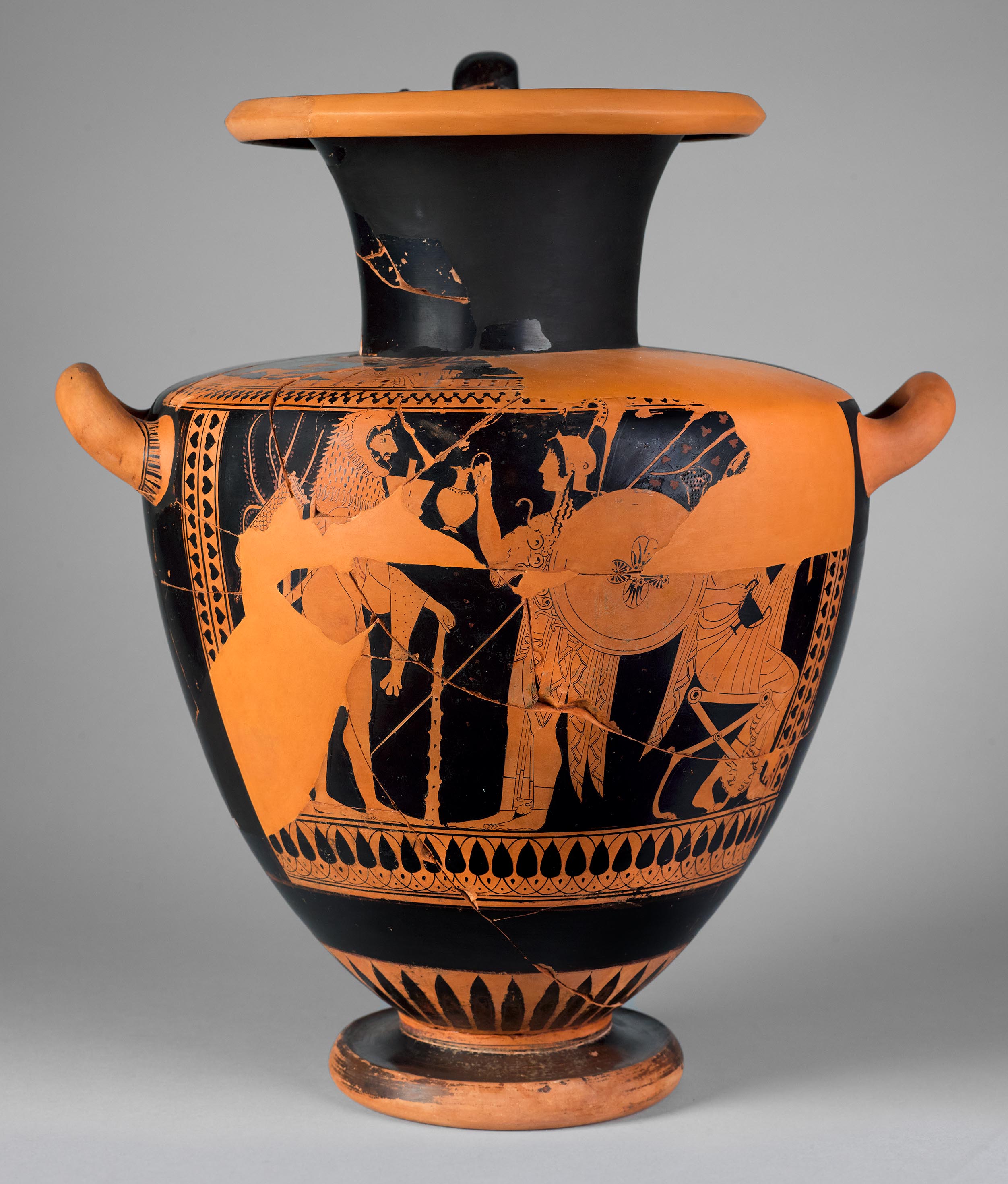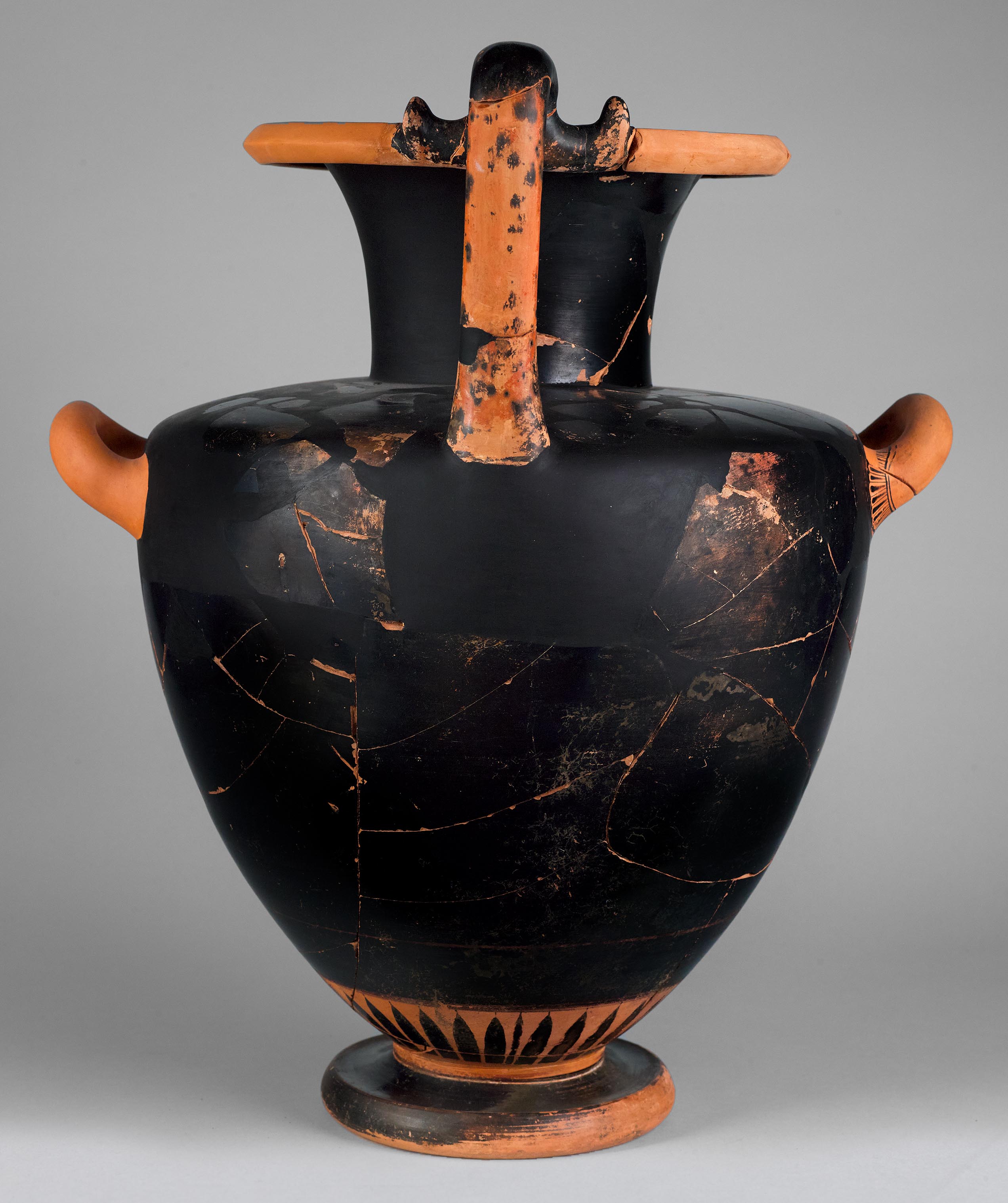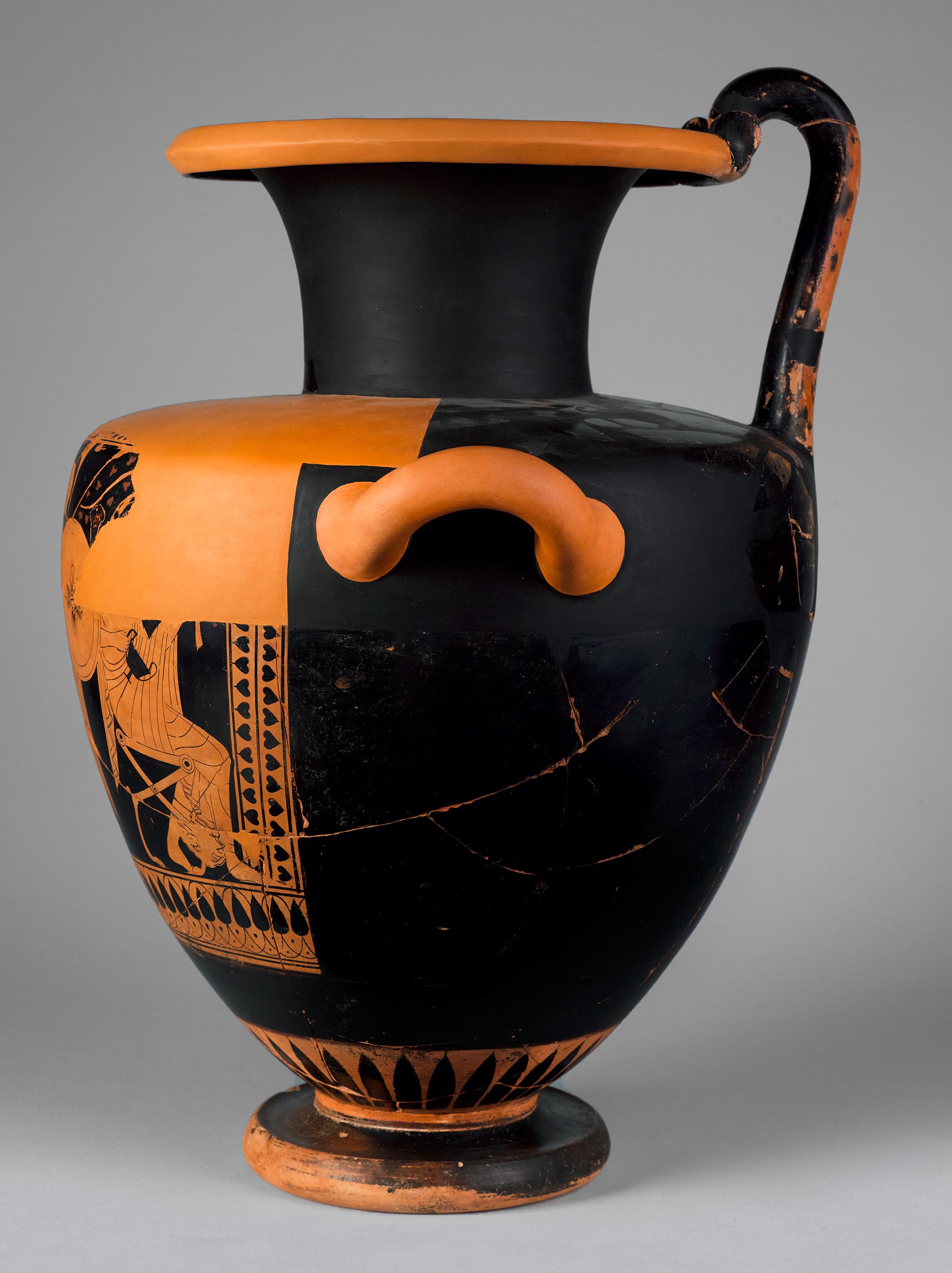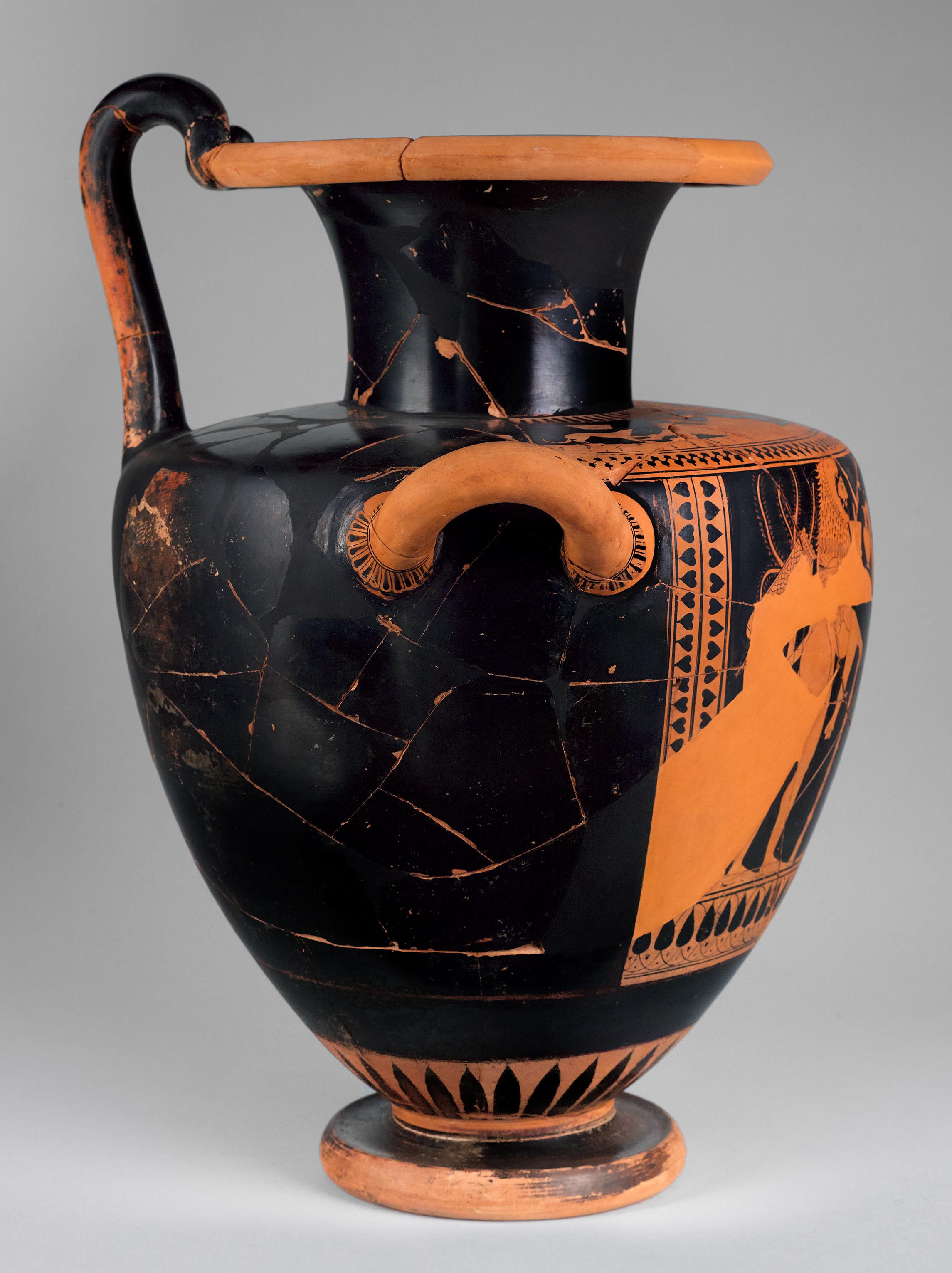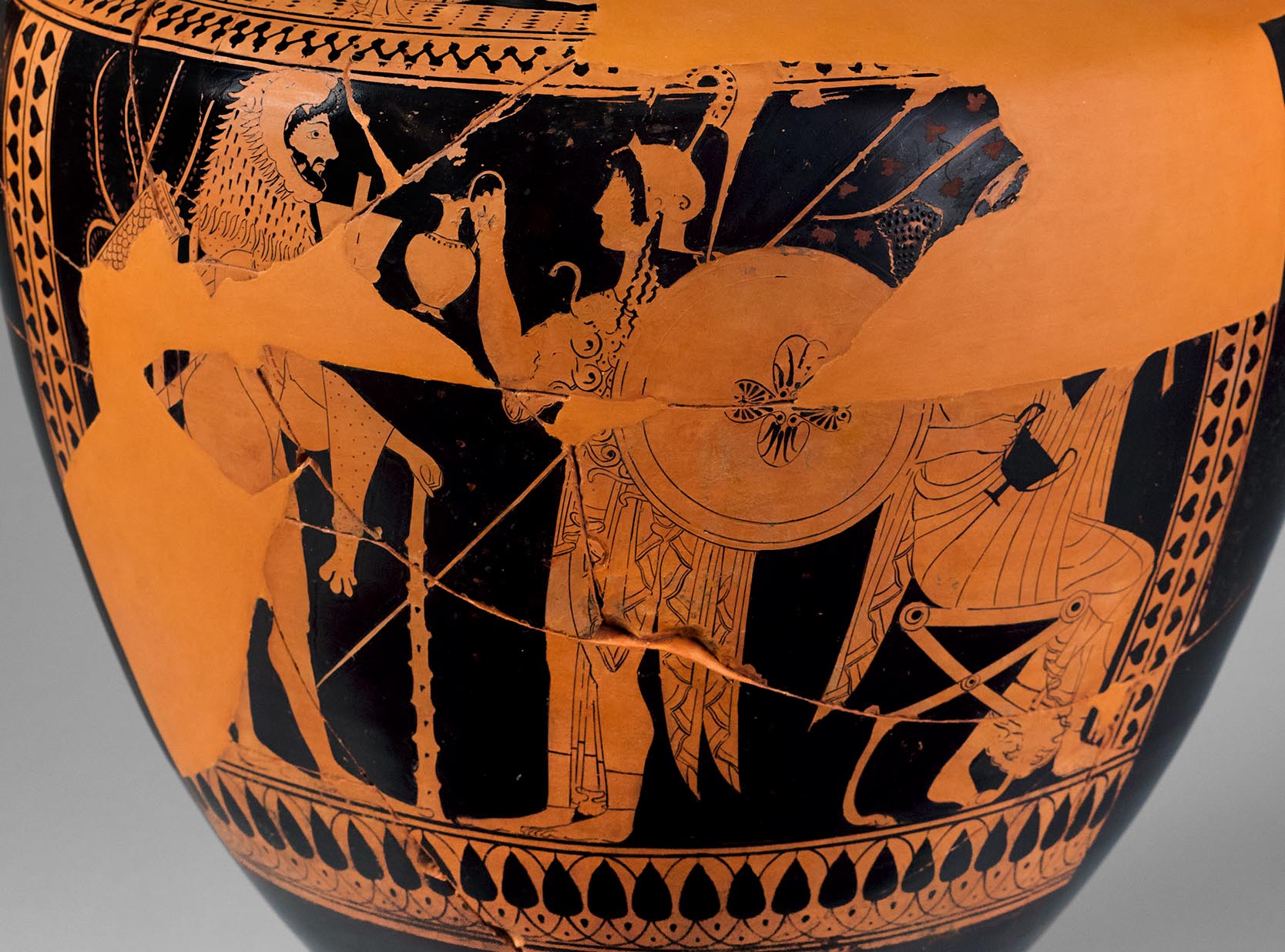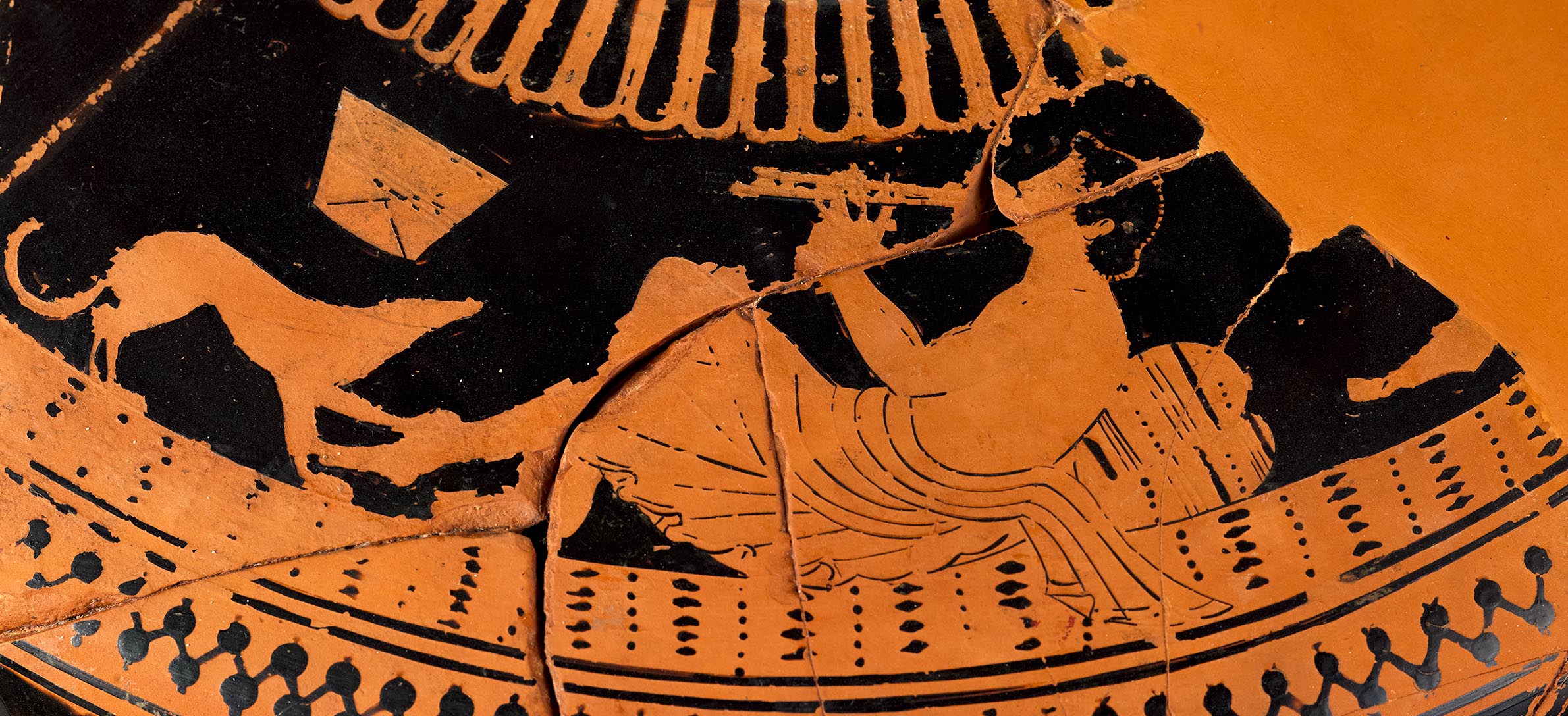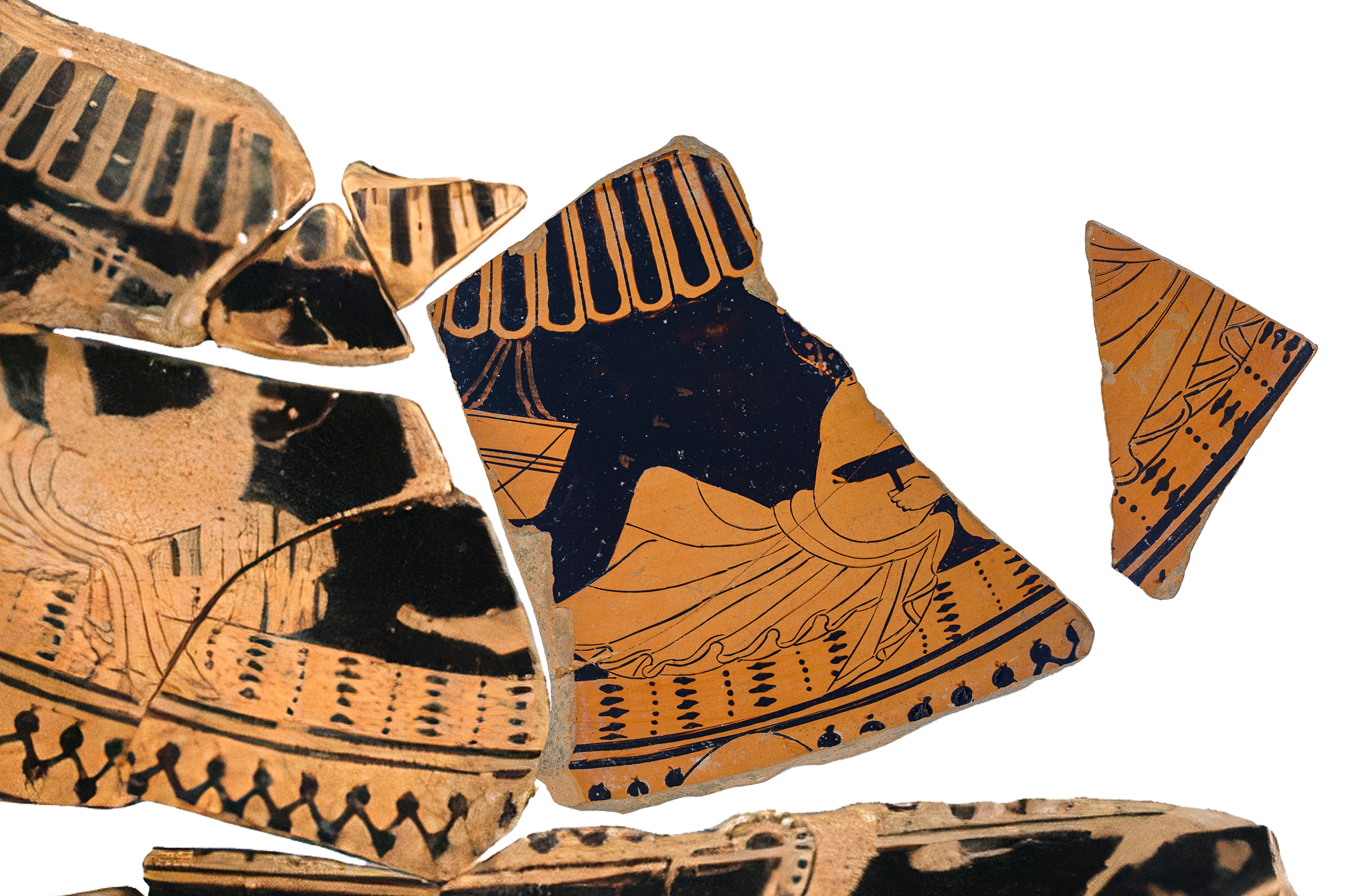Provenance
Formerly “Philadelphia market” (Abbreviation: ARV2J. D. Beazley. Attic Red-Figure Vase-Painters. 2nd ed. Oxford, 1963 34.9); 1986, gift, Dr. Herbert A. Cahn to Princeton University. Two joining fragments in Florence (J. D. Beazley, Campana Fragments in Florence [Oxford, 1933], pl. 1.15–16) suggest that it was found in Italy.
Shape and Ornament
Wide mouth with ridged, biconical lip. Tall, offset neck, black. Interior of mouth and neck black; exterior of the lip reserved. Deep, slightly sloping shoulder. Shoulder panel framed laterally by reserved stripes, above by band of black tongues. Groundline of pomegranate nets on shoulder, framed above and below by two black lines, extending beyond the framed panel on the body below. Two horizontal, upturned handles at join of shoulder and body; handles reserved, with roots encircled by black tongue pattern. Vertical handle, black, rises from shoulder to just above the rim; juncture with rim flanked by rotelle. Ovoid body. Lower panel on body bordered on either side by ivy vines, with a chain of lotus buds below framed by two black lines. Below black lines, red stripe encircles lower body. Zone of rays extends from the base. Torus foot with concave upper surface, black on top, separated from body by reserved fillet; resting surface and underside reserved.
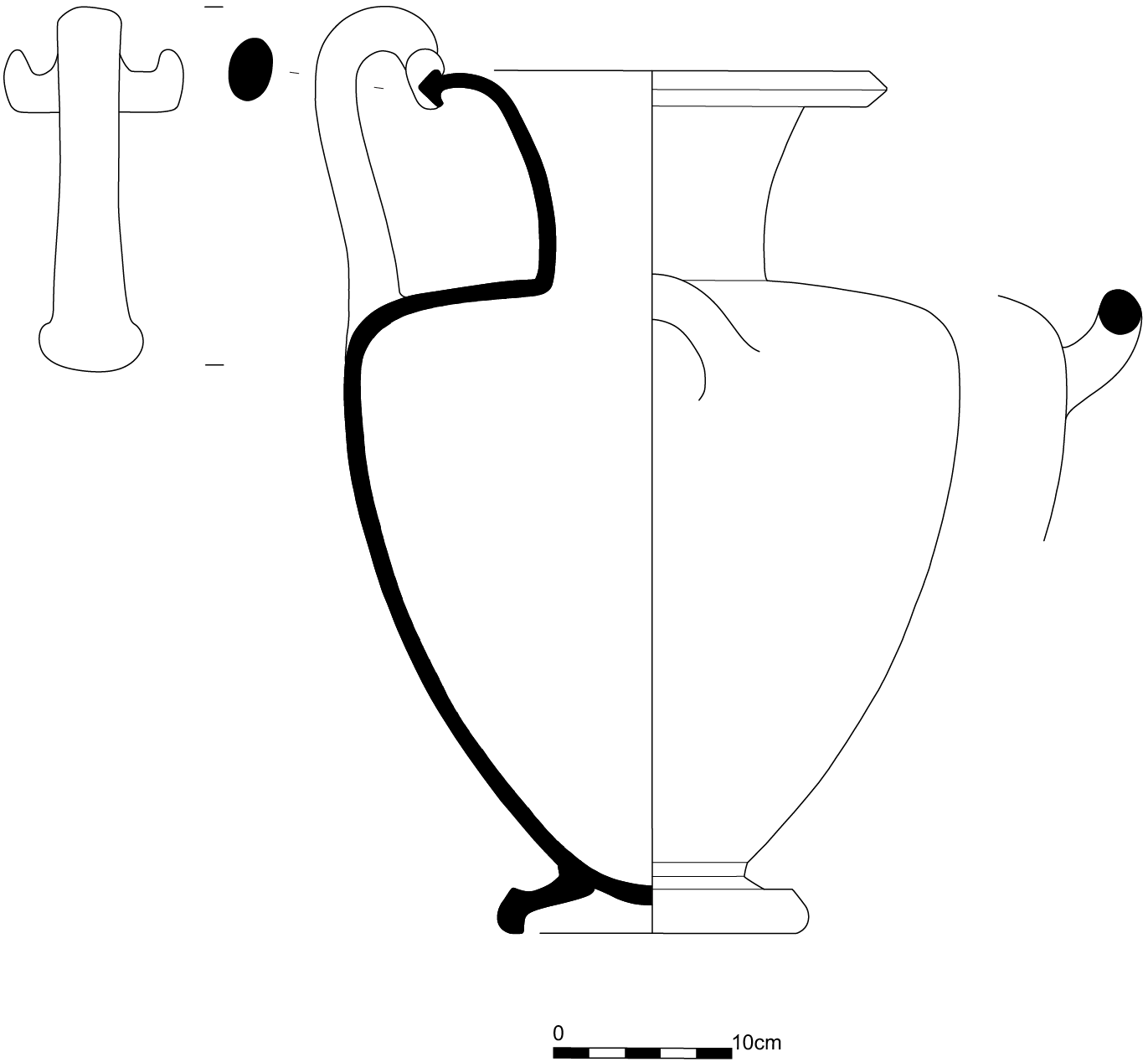
Subject
Shoulder. Symposion. Two reclining figures are preserved taking part in a symposion. A beardless youth at the left, his feet to the left, plays auloi with his head tilted back in profile while a dog paws at his foot. The youth wears a himation, exposing his upper body. Above the dog hangs a basket of trapezoidal shape. Farther right, the foot of the second symposiast is preserved beneath a second, more rounded basket. Much more of the second figure is preserved on a joining fragment in Florence, formerly in the Campana Collection (infra). He too wears a himation exposing his upper body, with his feet to the left. His head is lost. He holds a black kylix in his left hand and turns around to extend his right arm toward a third symposiast at right, partly preserved on a smaller, nonjoining fragment, also in Florence. The symposiasts recline on a patterned couch or mattress that stretches along the length of the panel, directly on the pomegranate chain below. The legs of the couch are not shown, and it is not clear whether this is an attempt to maximize the space available for the figures or is an indication that the mattress rests on the ground, as perhaps suggested by the small dog standing on it.
Body. Herakles, Athena, and Dionysos. Herakles stands at the left, in profile to the right, his legs slightly spread as he rests his left hand on his club, which stands vertically on the ground. With his right hand he holds a kantharos just below his face. Herakles wears his lion skin on his head and shoulders and drapes one of the paws over his left arm. A sword hangs on his left hip. Beyond and behind him is a small tree, in which his quiver, decorated with a scale pattern, is suspended. Facing him at the right stands Athena in profile to the left, fully armed with an Attic helmet, spear, snake-fringed aegis, and a shield bearing a lotus bud and palmette device. Her helmet crest extends into the pomegranate frieze on the shoulder. She holds an oinochoe in her raised right hand in order to fill Herakles’s cup. Her himation falls in elaborate zigzag folds over her chiton. At the far right, Dionysos sits on a diphros okladias (folding stool), his legs to the right. Only a portion of his head survives, but he clearly faces to the right in profile, away from Athena and Herakles. He wears a chiton and himation and holds a black kantharos in his right hand. In his left hand is a grapevine, from which a bunch of grapes hangs behind his head. Like those of Athena, the folds of his himation fall in symmetrical zigzags.
Attribution and Date
Attributed to the Dikaios Painter [J. R. Guy]. Circa 510 BCE.
Dimensions and Condition
h. 48.8 cm; w. 43.9 cm; diam. 35.9 cm; diam. of mouth 26.5 cm; diam. of foot 17.8 cm. Broken and mended with missing pieces restored in plaster. The vase was reassembled by conservator Jane Gillies in 1996, but a few small pieces could not be incorporated. Major losses to the figural scene include the right leg and midsection of Herakles, the head and shoulders of Dionysos, and the right side of the symposion scene on the shoulder (preserved in part in fragments in Florence [infra]). Right handle completely restored. Short sections of the neck and mouth preserved. Lower half of the body preserved, including the foot, which has been reattached. Decoration worn in places, especially the face and shield of Athena, the body and face of the symposiast at left, and the body of the dog. Much of the black gloss on the side of the foot has worn away, as has much of the slip on the vertical handle. Loss of gloss around many of the breaks. Sections of the back, in particular around the handle, have misfired mottled red.
Technical Features
Preliminary sketch. Relief contours. Accessory color. Red: inscriptions; stripe on lower body; the leaves of the vine and the tree; the quiver strap; the straps of Herakles’s baldric. The grape bunch executed with raised clay pellets.
Inscriptions
Shoulder. EVΘV along the left side of the panel, behind the hanging basket. XAIPE above and to the left of the knee of the leftmost symposiast; retrograde. XPE above the extended foot of the fragmentary symposiast.
Body. [H]EPAKΛEN between the lower bodies of Herakles and Athena. AΘEVIAΣ to the left of Athena’s head; retrograde. EVΘVMON between Athena’s legs and Dionysos. ΔIONVN (complete) to the right of Dionysos’s torso.
Incised graffiti in three places under foot:
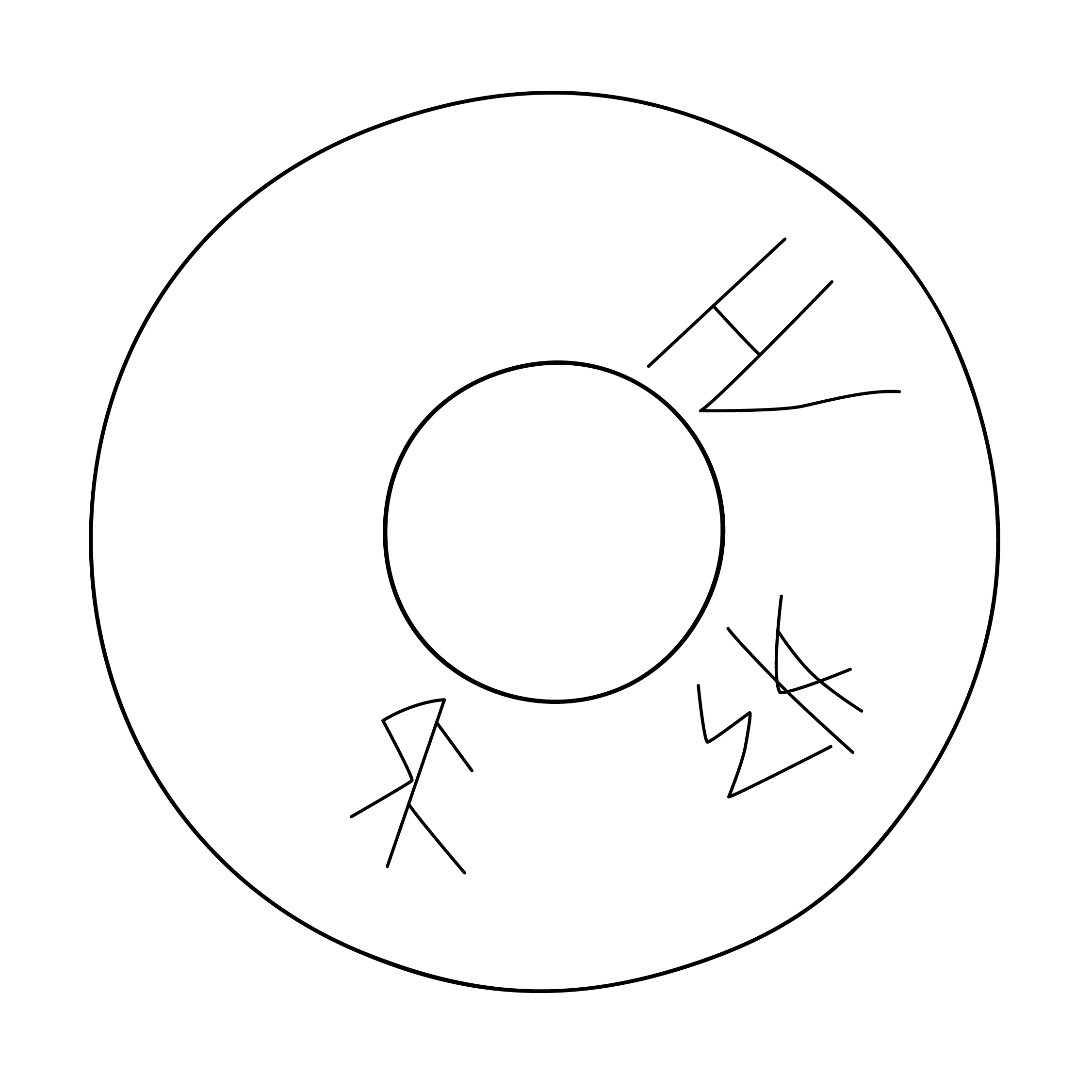
Bibliography
Abbreviation: ARV2J. D. Beazley. Attic Red-Figure Vase-Painters. 2nd ed. Oxford, 1963 34.9, 1621; J. Boardman, in Abbreviation: LIMCLexicon Iconographicum Mythologiae Classicae. 1981–2009 5 (1990), 149, no. 3173, s.v. “Herakles”; Abbreviation: AVIImmerwahr, H. R., and R. Wachter. Attic Vase Inscriptions. https://avi.unibas.ch (last update October 25, 2018). 6824; Abbreviation: BAPDBeazley Archive Pottery Database. http://www.beazley.ox.ac.uk 200183.
Comparanda
For the Dikaios Painter, see Abbreviation: ARV2J. D. Beazley. Attic Red-Figure Vase-Painters. 2nd ed. Oxford, 1963 30–32, 1621; Abbreviation: ParalipomenaJ. D. Beazley. Paralipomena: Additions to Attic Black-Figure Vase-Painters and to Attic Red-Figure Vase-Painters. Oxford, 1971 174, 324, 509; Abbreviation: BAdd2Carpenter, T. H., ed. 1989. Beazley Addenda: Additional References to ABV, ARV2, and Paralipomena. 2nd ed. Oxford: Published for the British Academy by Oxford University Press. 104, 157; P. Diez del Corral Corredoira, “Anfítrite y Ariadna: Ambigüedades iconográficas en una hidria del Pintor de Dicaios,” Abbreviation: NumAntClNumismatica e antichità classiche: Quaderni ticinesi 40 (2011): 129–40. Beazley attributed this hydria to “Sundry Pioneer,” but the attribution by Guy to the Dikaios Painter is well founded. Cf., for instance, Herakles’s eye, with its long tear duct, to the eyes of the figures on London E 255 (Abbreviation: ARV2J. D. Beazley. Attic Red-Figure Vase-Painters. 2nd ed. Oxford, 1963 31.2; Abbreviation: BAPDBeazley Archive Pottery Database. http://www.beazley.ox.ac.uk 200175), especially the eye of Apollo; and those on a hydria, also attributed to the Dikaios Painter by Guy, in the Geneva art market (Phoenix Ancient Art, The Painter’s Eye: The Art of Greek Ceramics, auc. cat. [Geneva, 2006], 38–43, no. 9). The Geneva hydria is also related to Princeton’s vase in the execution of Herakles’s lion skin and Athena’s aegis, and in the drawing of both figures’ faces. For the attribution of the Geneva hydria to the Dikaios Painter, cf. its use of the crab shield device with London E 255 (supra). Cf. also the execution of the hair and fillet of the female at the far right on the Geneva hydria with the hair of Leto on Vienna, Univ. 631 b (Abbreviation: ARV2J. D. Beazley. Attic Red-Figure Vase-Painters. 2nd ed. Oxford, 1963 30.1; Abbreviation: BAPDBeazley Archive Pottery Database. http://www.beazley.ox.ac.uk 200174), which Beazley considered to be the Dikaios Painter’s best work. The elaborate zigzag folds of Athena’s drapery on Princeton’s hydria are also paralleled on the Vienna amphora (supra). For the sympotic scene on the shoulder, cf., attributed to the Dikaios Painter, Brussels R 351 (Abbreviation: ARV2J. D. Beazley. Attic Red-Figure Vase-Painters. 2nd ed. Oxford, 1963 31.7; Abbreviation: BAPDBeazley Archive Pottery Database. http://www.beazley.ox.ac.uk 200192), with its similarly patterned and continuous cushion resting directly on an ornamental frame. Cf. also the symposion on the shoulder of Bonn 70 (Abbreviation: ARV2J. D. Beazley. Attic Red-Figure Vase-Painters. 2nd ed. Oxford, 1963 28.12; Abbreviation: BAPDBeazley Archive Pottery Database. http://www.beazley.ox.ac.uk 200141), which was signed by Euthymides, of whom Beazley considered the Dikaios Painter to be an imitator. For the use of a tongue pattern around the root of reserved handles, cf. Bonn 70 (supra); near the Dikaios Painter, Paris, Louvre G 51 (Abbreviation: ARV2J. D. Beazley. Attic Red-Figure Vase-Painters. 2nd ed. Oxford, 1963 32.1; Abbreviation: BAPDBeazley Archive Pottery Database. http://www.beazley.ox.ac.uk 200193).
When Beazley encountered in the Philadelphia market the fragments that would become the Princeton hydria, he associated with them two fragments that he had seen much earlier in Florence (joint inv. 151197), and accepted Levi’s conclusion that they were from the same vase: D. Levi, CVA Florence 1 (Italy 8), 376, pl. 1.19; J. D. Beazley, Campana Fragments in Florence (Oxford, 1933), 7, B15, and B16. Their association has since been kindly confirmed by M. Iozzo, director of the National Archaeological Museum in Florence (private communication, November 2018). The larger fragment (B16) joins the Princeton vase, giving most of the second symposiast on the shoulder, and vindicating Beazley’s suggestion that the curved object below was a helmet crest, that of the Athena depicted on the body of the hydria. On the smaller fragment (B15), the mattress of the couch seems slightly thinner, but this may be accounted for by the overhang of the himation worn by what is clearly a third symposiast at far right. For a reconstruction of the hydria with the additional fragments in Florence, see pl. 33.3.
For the shape within the work of the Pioneers and their immediate followers, see H. Bloesch, “Stout and Slender in the Late Archaic Period,” Abbreviation: JHSJournal of Hellenic Studies 71 (1951): 35–37; E. Diehl, Die Hydria: Formgeschichte und Verwendung im Kult des Altertums (Mainz, 1964), 61–63; D. von Bothmer, “Review of Diehl 1964,” Abbreviation: GnomonGnomon: Kritische Zeitschrift für die gesamte klassische Altertumswissenschaft 37 (1965): 599–608; J. Gaunt, “The Berlin Painter and His Potters,” in Abbreviation: Padgett, Berlin PainterJ. M. Padgett, with contributions by N. T. Arrington et al. The Berlin Painter and His World: Athenian Vase-Painting in the Early Fifth Century B.C. Princeton, 2017, 88. Analyzing the shapes, Bloesch divided the Pioneer Workshop into two groups—one headed by Euphronios and the second by Phintias and Euthymides, which inclueded the Dikaios Painter—that corresponded with the division of the Workhop’s painters based on style. Williams (“Workshop View,” 148) has recently suggested that within the group headed by Phintias and Euthymides, there may have been two separate potter workshops, with Bloesch’s Eukleo Potters A and C associated with Euthymides, and Potter B with Phintias. The Dikaios Painter, to judge from his amphorae, seems to have been closely connected with Potter A of the Eukleo Group, further suggesting his close connection with Euthymides: see Bloesch, “Stout and Slender,” 31–33. The profile of the rim on Princeton’s hydria is also distinctive for its biconical lip, which may be connected to a series of hydriai likely potted by a single individual and decorated by the Berlin Painter, who was himself trained by members of the Pioneer Group: C. M. Robertson, “The Origins of the Berlin Painter,” Abbreviation: JHSJournal of Hellenic Studies 70 (1950): 23–34; Gaunt, “Berlin Painter and His Potters,” 97–98. Also cf. Vatican 16568 (Abbreviation: ARV2J. D. Beazley. Attic Red-Figure Vase-Painters. 2nd ed. Oxford, 1963 209.166, 1634; Abbreviation: BAPDBeazley Archive Pottery Database. http://www.beazley.ox.ac.uk 201984).
Herakles and Athena facing one another with the instruments of libation is a relatively common subject: see J. D. Beazley, “An Amphora by the Berlin Painter,” Abbreviation: AntKAntike Kunst 4, no. 2 (1961): 49–67, esp. 55–58; Boardman, in Abbreviation: LIMCLexicon Iconographicum Mythologiae Classicae. 1981–2009 5 (1990), 148–54, pls. 140–42, nos. 3156–78, s.v. “Herakles.” For the composition of Herakles resting his upright club on the ground and holding a kantharos while Athena raises an oinochoe, cf., by the Deepdene Painter, Los Angeles 50.8.21 (Abbreviation: ARV2J. D. Beazley. Attic Red-Figure Vase-Painters. 2nd ed. Oxford, 1963 500.28; Abbreviation: BAPDBeazley Archive Pottery Database. http://www.beazley.ox.ac.uk 205127); by the Geras Painter, Paris, Cab. Méd. 415 (Abbreviation: ARV2J. D. Beazley. Attic Red-Figure Vase-Painters. 2nd ed. Oxford, 1963 287.29; Abbreviation: BAPDBeazley Archive Pottery Database. http://www.beazley.ox.ac.uk 202600); by the Dutuit Painter, Paris, Louvre G 203 (Abbreviation: ARV2J. D. Beazley. Attic Red-Figure Vase-Painters. 2nd ed. Oxford, 1963 306.1; Abbreviation: BAPDBeazley Archive Pottery Database. http://www.beazley.ox.ac.uk 203142). The Berlin Painter’s type A amphora in Basel also shows Herakles clutching a kantharos, albeit without an upright club, before Athena, who holds an oinochoe on the opposite side: Basel BS 456 (Abbreviation: ARV2J. D. Beazley. Attic Red-Figure Vase-Painters. 2nd ed. Oxford, 1963 1634.1 bis; Abbreviation: BAPDBeazley Archive Pottery Database. http://www.beazley.ox.ac.uk 275090). To distinguish between scenes in which Herakles holds a phiale, the proper implement of libation, and those in which he holds a kantharos, Beazley (“Amphora,” 58) termed the latter scenes “regaling.” On a black-figure amphora in Australia, however, Athena pours liquid into a kantharos held by Herakles before an altar, clearly indicating that he might use this type of cup for libation: Hobart 45 (Abbreviation: ParalipomenaJ. D. Beazley. Paralipomena: Additions to Attic Black-Figure Vase-Painters and to Attic Red-Figure Vase-Painters. Oxford, 1971 172; Abbreviation: BAPDBeazley Archive Pottery Database. http://www.beazley.ox.ac.uk 351266). Mortals also poured libations from kantharoi: cf. Harvard 1960.371 (S. Bundrick, “Selling Sacrifice on Classical Athenian Vases,” Abbreviation: HesperiaHesperia: The Journal of the American School of Classical Studies at Athens 83 [2014]: fig. 4; Abbreviation: BAPDBeazley Archive Pottery Database. http://www.beazley.ox.ac.uk 9020306). For the suggestion that the kantharos, as used by mortals, indicates a libation to Dionysos, see Abbreviation: Neils and Oakley, Coming of AgeNeils, J., and J. H. Oakley. 2003. Coming of Age in Ancient Greece: Images of Childhood from the Classical Past. Exhibition catalogue. Hood Museum of Art, Dartmouth College. Hanover, NH., 292. For Dionysos himself using a kantharos for a libation, cf., inter alia, Boston 00.334 (Abbreviation: ARV2J. D. Beazley. Attic Red-Figure Vase-Painters. 2nd ed. Oxford, 1963 126.27; Abbreviation: BAPDBeazley Archive Pottery Database. http://www.beazley.ox.ac.uk 201055).
In such scenes there is usually little to suggest a specific narrative setting. Additional figures, most commonly Dionysos or Poseidon, are typically interpreted simply as divine companions (Boardman, in Abbreviation: LIMCLexicon Iconographicum Mythologiae Classicae. 1981–2009 5 [1990], 152–53, s.v. “Herakles”). Although a seated Dionysos is most often represented accompanied by satyrs and/or maenads (e.g., by Euthymides, St. Petersburg 624: Abbreviation: ARV2J. D. Beazley. Attic Red-Figure Vase-Painters. 2nd ed. Oxford, 1963 28.15; Abbreviation: BAPDBeazley Archive Pottery Database. http://www.beazley.ox.ac.uk 200132), or in the midst of a symposion (e.g., by the Troilos Painter, New York 1986.11.12: Abbreviation: BAdd2Carpenter, T. H., ed. 1989. Beazley Addenda: Additional References to ABV, ARV2, and Paralipomena. 2nd ed. Oxford: Published for the British Academy by Oxford University Press. 399; Abbreviation: BAPDBeazley Archive Pottery Database. http://www.beazley.ox.ac.uk 15922), his orientation on the Princeton hydria, with his back to Athena and Herakles, suggests that he is part of a larger group that is not depicted: cf., by the Sosias Painter, Berlin F 2278 (Abbreviation: ARV2J. D. Beazley. Attic Red-Figure Vase-Painters. 2nd ed. Oxford, 1963 21.1, 1620; Abbreviation: BAPDBeazley Archive Pottery Database. http://www.beazley.ox.ac.uk 200108), on the exterior of which Athena leads Herakles to an assembly of the gods, who face away from Herakles. The fact that Athena and Herakles are not actively proceeding into the company of the other gods does not preclude this interpretation; cf., by Makron, Bochum S 1062 (N. Kunisch, Makron [Mainz, 1997], pls. 118–19; Abbreviation: BAPDBeazley Archive Pottery Database. http://www.beazley.ox.ac.uk 13378), which juxtaposes a scene of Herakles and Athena facing one another on the interior, with an assembly of the gods that includes a seated Dionysos on the exterior. As noted by Boardman (Abbreviation: LIMCLexicon Iconographicum Mythologiae Classicae. 1981–2009 5 [1990], 153), Herakles’s pose is often a restful one when he is shown opposite Athena. The libation on the vase in Princeton may thus be an act of welcome as the hero prepares to join the assembly of the gods.
For a general overview of symposia without klinai and the possible Dionysiac resonances of such images, see F. Heinrich, “Bodengelage im Reich des Dionysos: Gelagebilder ohne Klinen in der attischen Bilderwelt des 6. und 5. Jahrhunderts v. Chr.,” in Besorgte Mütter und sorglose Zecher: Mythische Exempel in der Bilderwelt Athens, ed. M. Meyer (Vienna, 2007), 101–53. For a discussion of sympotic scenes without klinai and the possible connection to primitive symposia, or symposia in Athens’s distant past, see K. Topper, The Imagery of the Athenian Symposium (Cambridge, UK, 2012) 23–52. For the interpretation that such scenes are related to dining at contemporary religious festivals, see B. Kaeser, “Symposion im Freien,” in Abbreviation: Kunst der SchaleKunst der Schale, Kultur des Trinkens: Ausstellung der attischen Kleinmeisterschalen des 6. Jahrhunderts v. Chr. Edited by K. Vierneisel, B. Kaeser, and B. Fellmann. Munich, 1990, 306–9. For the association of such scenes with the City Dionysia in particular, see C. Sourvinou-Inwood, Tragedy and Athenian Religion (Lanham, MD, 2003), 79–88.
Beazley (Abbreviation: ARV2J. D. Beazley. Attic Red-Figure Vase-Painters. 2nd ed. Oxford, 1963 34.9) noted that the sigmas in the inscriptions, which are written sideways, have the form of nus, a phenomenon found on some other vases of the Pioneer Group: e.g., Paris, Louvre G 41 (Abbreviation: ARV2J. D. Beazley. Attic Red-Figure Vase-Painters. 2nd ed. Oxford, 1963 33.8; Abbreviation: BAPDBeazley Archive Pottery Database. http://www.beazley.ox.ac.uk 200182). Immerwahr (Abbreviation: AVIImmerwahr, H. R., and R. Wachter. Attic Vase Inscriptions. https://avi.unibas.ch (last update October 25, 2018). 6824) emends the inscription EVΘVMON to read EVΘVMOΣ and suggests that the partial inscription EVΘV on the shoulder must be the same name. Although noting that the last letter of the inscription is clearly a nu and not a sideways sigma, Immerwahr suggests this could be a mistake by the painter, perhaps confused by the similarity of the sideways sigma with the nu. The painter’s spellings in general suggest a lack of literacy. The name EVΘVMON does not occur on any other known vase, while the name EVΘVMOΣ becomes common later. Cf., e.g., Myson’s famous Croesus amphora, on which the servant who stokes the pyre is named EVΘVMOΣ: Paris, Louvre G 197 (Abbreviation: ARV2J. D. Beazley. Attic Red-Figure Vase-Painters. 2nd ed. Oxford, 1963 238.1; Abbreviation: BAPDBeazley Archive Pottery Database. http://www.beazley.ox.ac.uk 202176). Immwerwahr also suggests that the name might be a shortened version of Euthymides, which occurs without a verb on Paris, Louvre G 41 (supra), attributed to the Pioneer Group. If Immerwahr is correct in restoring EVΘVMOΣ, which later appears as a completely different name from Euthymides, the name on Princeton’s hydria should perhaps also be kept separate from Euthymides.
Regarding the graffiti on the underside of the foot, the lambda-eta ligature fits into Johnston’s type 2F (Abbreviation: Johnston, TrademarksJohnston, A. W. 1979. Trademarks on Greek Vases. Warminster: Aris and Philips., 221–23). This trademark is most popular in the Leagros Group, but also occurs on several Pioneer vases: cf., inter alia, Paris, Louvre G 41 (supra; see also Abbreviation: Johnston, TrademarksJohnston, A. W. 1979. Trademarks on Greek Vases. Warminster: Aris and Philips., 152, no. 37); by Euthymides, Munich SH 2309 (Abbreviation: ARV2J. D. Beazley. Attic Red-Figure Vase-Painters. 2nd ed. Oxford, 1963 27.4, 1620; Abbreviation: BAPDBeazley Archive Pottery Database. http://www.beazley.ox.ac.uk 200157). The “SE” mark opposite the lambda-eta ligature is closely paralleled on a black-figure doubleen by the Red-Line Painter: University College Dublin 103 (CVA Dublin 1 [Ireland 1], pl. 13.1–2; Abbreviation: BAPDBeazley Archive Pottery Database. http://www.beazley.ox.ac.uk 9031197). (We are grateful to A. W. Johnston for this reference.) The position of the “SE” mark in relation to the lambda-eta ligature is similar to other Leagran and Pioneer marks, such as the “XV” on Paris, Louvre G 41. Johnston states that the “SK” mark is rather odd and unparalleled (private communication, October 22, 2019).
